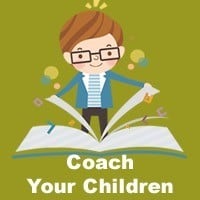
Over the years I received a number of questions from people about mind mapping for children. How can they teach their kids about mind mapping?
I am very glad more and more parents want to do this. I think it shows they are investing more on the education of their children than most people do.

Let’s have a look at how you can be a mind mapping coach to your child. Mind mapping with children is a little bit different than with adults, I think, so read along. Give your child the benefit of outlining all their school work, personal projects and other ideas in a visual mapping.
Mind Mapping Comes Natural
As you know from classical theory we use our left brain for the logical things and words. The right brain side is more for images and colours. You know that this is not as black and white as people usually try to tell you. Still, there is a small difference between the two, so using the term left and right brain thinking can be used for that.
Many people try to work on this thing called whole brain thinking. Your child has a really big advantage over you when it comes to this. You see, children don’t know about writing words when they are young. This is something they learn when they grow up.
The way your child uses his or her brain is already whole brain wise. This means we are preaching to the choir when we talk about this with them…
And really, who starts talking to kids about brain sides, words and images, whole brain thinking etc. when they explain mind mapping? Did you?
You are not talking about some rusty adult who has a dominant left or right brain and who needs an explanation about this. You are talking to a child. Put yourself in their shoes and explain things to them. Or make it even more fun using the simple system I will tell you later.
First we have a look at the benefits of mind mapping for children.
When your child ‘learns’ to mind map, they will get the gift of making school work or any other type of information much more accessible. They will remember it much better because it uses the same kind of methods they use subconsciously.
Learning becomes fun (as it was when they were really, really young). They will associate learning with fun, playing, joy, etc. This will help them a lot in their studies.
Children are already capable of taking in lots of information re
ally fast. This only accelerates when they use visual overviews or mind maps.

For me, it is also important to let you know that mind maps are not something you should be using all the time. There are moments when a mind map is a really good solution for writing down notes. Other moments, you can best use other methods (traditional note taking for instance).
Just remember, mind mapping is only a tool. You don’t need or have to use it for everything. After all, do you use a hammer to fix every problem in your home???
Mind Mapping And Parents
There are some people who read this information and don’t really know about mind mapping. All they heard is that mind mapping is something their child will benefit from. Glad you are taking the time to read this information.
Before I will repeat myself, I want to tell you that you can learn all about mind mapping on this website in various in-depth writings. Have a look at Mind Mapping 101, mind mapping on paper, and digital mind mapping if you want to know more about that.
Right, to give you the 5-second explanation…
A mind map is a visual overview of information which uses colours, words, and images and connects related information to each other using branches. A mind map uses about the same structure as branches of a tree.
These days many parents are really involved in the education of their children. This is of course very good. Giving your children the right foundation and information is very important in helping them succeed in life.
What I also see is that parents want to make things easier for their children. Not just around the house, but also at school. I don’t think you should make things easier for children (and people in general). As I quoted Jim Rohn many times, don’t wish for things to be easier, wish you were better.
You should wish your children become better in what they do. Challenge them. Make learning adventurous. Make it fun. But always help them grow.
That is what teaching your child mind mapping will do as well. It becomes easier to study, understand, outline, and research. But this new skill will open new doors as well that ask for more skills. Your child will grow because of this.
Just imagine, you are making a book report. Now instead of writing all things in a traditional linear style, you get to draw a picture of what you read!!! What is more exciting and interesting? What would you like to do? What will you work on?
And even if you have a mind map book report, you can still transform that into a report the teacher wants to read or needs to get. Imagine the surprise when you also add the mind map of your report to your sheets of traditional notes. This almost has to impress the teacher!
While most parents who train their children in mind mapping have the best intentions with this, there are a couple of things that usually go wrong. Knowing these will help you to improve the process of mind mapping with your children a lot.
Problem 1: You MUST learn mind mapping
Do you think a child wants to learn when you force it upon them to learn something? I think most children will really hate that. Don’t even talk about mind mapping at all. This will make it a lot more fun for children because they don’t feel like they are learning something new (but they are exploring new things).
Problem 2: Create a PERFECT mind map
Do the mind maps of your child follow all the rules of a perfect map? If so… does your child love to make them?
What I often see is that when you don’t focus on the map, but on the story in the map, your child learns a lot more.
Mind maps are perfect tools to tell stories. Let your child tell the story of his or her map. When the story is fun and good, the information is usually correct. Don’t be fooled about the word stories. When we want to remember information, the best thing we can do is tell stories about it. This way we create images and movies in our head that show us all the information.
Wouldn’t it be amazing if you don’t just learn facts about history, but you actually are part of the events taking place? You are part of the story! That will be a story you will never forget again.
So don’t try to create a perfect mind map, following all the rules of mind mapping. When the map does the job, the goal is achieved with that map. A perfect map usually is a bad thing to work on. The information has to be transformed into something your child loves to work with, remember or investigate.
Problem 3: A mind map is the BEST solution, always
Absolutely, hands down, no way!!! A mind map is just A solution, not THE or the BEST solution. The moment you only give a mind map as a solution to your child, you are limiting your child in the way they play with the ideas and information.
Yes, a mind map is a good tool for many solutions, but try to remember this: when you only have a hammer, every problem looks like a nail…
Make sure you also train your child or children about memory techniques, reading methods, ways to summarize ideas, presentation tools, etc.
This way you give your child the tools and techniques to really master information and make studying fun and easy or easier.
In general, make sure you look at mind maps as a tool. Use them the way your children benefit most from them. This may be by creating maps without images, or by re-connecting lower nodes of different branches together. In normal mind mapping this is a big NO, when you child benefits from doing these things, I would say… DO IT!
Now “parent who is also the personal mind map coach of his/her child”, let’s find out how to create mind maps with children.
MAKING MIND MAPS WITH CHILDREN
To make sure children of many ages benefit from this, I divided the children in 2 groups. We have the young children ages 6 to 12, and the teens who are 12+ years. The approach to making the benefit from mind maps is slightly different. You be the judge which approach you like to take.
Young Children (6 to 12)
Young children who learn about mind mapping often still like to draw pictures and use colours in their writing. This is a big benefit since we will be using that.
The first step is to ask them to listen while you tell them a story. This can be a fairy tale, or something from school, or about the upcoming holiday that you like to share with them.
Give them a piece of paper, lots of colours and share your patience with them.
You tell them they have to create a picture of the things you will tell them. Make sure your story is really vivid, using many “image words”. Words like castle, clouds, horse, train, etc. You know, things that are easy to draw.
You tell the story, your child draws the picture of this. Afterwards, ask them to tell the story to you using their drawing.
Does this work? Most of the time this works really well. Children often know exactly what you said using their own simple pointers.
The next step is to divide the paper into a number of areas. Coincidentally the number of areas is equal to the number of chapter, ideas, thoughts, etc. you have in a book or on a piece of paper.
If you have 5 chapters, divide the piece of paper into 5 sections. These can be of the same size when the notes you think your child will take are about the same amount.
Great, same idea. You tell what is in the book, your child draws the ideas into a story. The beauty of this is, each area of the paper is a chapter. Each story is now captured in pictures your child made. Probably the story is shown in a linear format.
Heh… what would happen if you drew a line between the images? Would that create a branch?
Well, there you have it. Your child just created a real mind map.
Now you can take this to the next level immediately. Here’s how. Look at the map. Where there is room for more information, improvement, clarification, just ask your child to draw another picture or write a word in the map. You now get sub branches in your map as well.
Do you think your child can create another map all by him or herself? Go ahead, just let them do this!
Oh… since you are a supportive parent (no tiger mum or dad) and you want to create the best learning environment for your child, don’t start to talk about what is ‘wrong’ with the map? I am sure when you create a mind map we all can find things that are wrong as well. The question you have to ask is simple: Does this overview or mind map help my child capture information better, increase their creativity, and make learning fun again?
If so, you did a wonderful job! If not, investigate, adjust and help your child improve.
Mind mapping with teens (ages 12+)
Where we were focussing on self expression and images with younger children, you can focus more on words with teens. They are probably already feeling less confident when drawing anyway. If they are not, just stimulate drawing. If they don’t like it, you should not make a big deal about it.
Right, what is the plan we use with teens.
With teens, you can talk about branches and associations already. The easiest way to start mind mapping for them is to create an empty mind map.
That’s right, you create an empty centre, with 4 to 6 branches around that main topic/centre. Create sub branches for each main branch. I suggest you make at least 3 sub branches per branch.
Now you give them a topic to work on. What works best in many cases is a topic they love to work on. For instance a hobby or another interest of them.
Just ask the question… what would you tell a person who wants to learn all about this?
Then… step back and let your teen create a mind map. They know everything about this topic so let them create the map. When they need more branches, most teens know they can simple create them by drawing lines from the topics in the map.
When you want to make this really fancy, you create a mind map skeleton that uses different colours. Leave those coloured pens on the table.
You can do this on a desktop computer, laptop or tablet as well. Create a skeleton or just show them how to add a new branch and how to navigate through the map. I did this with many teens from clients before. All of them stopped listening after I showed them how to add information. They just went wild and created their map(s).
When your teen is done mind mapping and all the information is in the map, ask them one question: does this map make things clear for people who want to learn about your topic?
With the teenager showing enthusiasm (…) you will see that they like it.
Now ask them what will happen when they start creating summaries for school, from their books and classes this way. Do they think this will help them?
Then ask them to create a mind map from a book they have to read. Make sure they know they can ask you any questions if they have any. You will be there for them, but you won’t interfere with their map creation. After they are done, look at the map together. You can even ask them to present the information to you using their map. They will love it. They will see that this is fun, saves time and is really simple to use.
So there you go…
Mind mapping with children and teens. This will be a wonderful gift you give them. Make sure you are not a teacher or someone who dictates them to do it like this or that. Guide them if they have questions. Encourage them to be creative and information smart.
NOTE:
The above is my way of introducing children and teens to mind mapping. The maps you create are probably not ‘real’ mind maps compared to the traditional mind maps by Tony Buzan. That’s ok. You don’t need to create perfect mind maps to make maps that work for you (or your child).
What I noticed is that you first lecture about mind mapping and then tell them rules about what to do and what not to do, children and teens lose interest. This way you can introduce them to mind mapping in a way they almost discover mind mapping themselves! And that makes it a whole lot more interesting to use of course.
WHAT’S NEXT?
When your child or teen makes their visual overview, you can always hint about small changes that will make their maps more traditional mind maps (if you like). Ask them to draw more things, use different colours, think more in sub branches, etc.
Also, ask them what they like to do with this technique they ‘discovered’. I am confident you will get things like give school presentations, take notes in class, summarize books, etc.
They know very well what to do with their new skill!
Finally, let them USE the map. Not just CREATE it, but also add things after they first created it. Remove information that is so clear they don’t need a map to remember it. You know… all the good stuff we do with our mind maps for work and study.
If you have any questions, please let me know. Share your results with our community.
Also, I wrote about a little system that helps you to create mind maps from 200+ page books, that you never read before… all in just one hour. You can learn more about that here.
Be sure to tweet about, or like this information on Facebook so others will learn about it as well. Just use the buttons just below this writing (or at the top)
Subscribe to the newsletter if you want to learn more about smart ways to use mind maps and become so productive you will be home on time to make sure you can be the mind map coach your children deserve!
Talk soon!
image credit: homework


